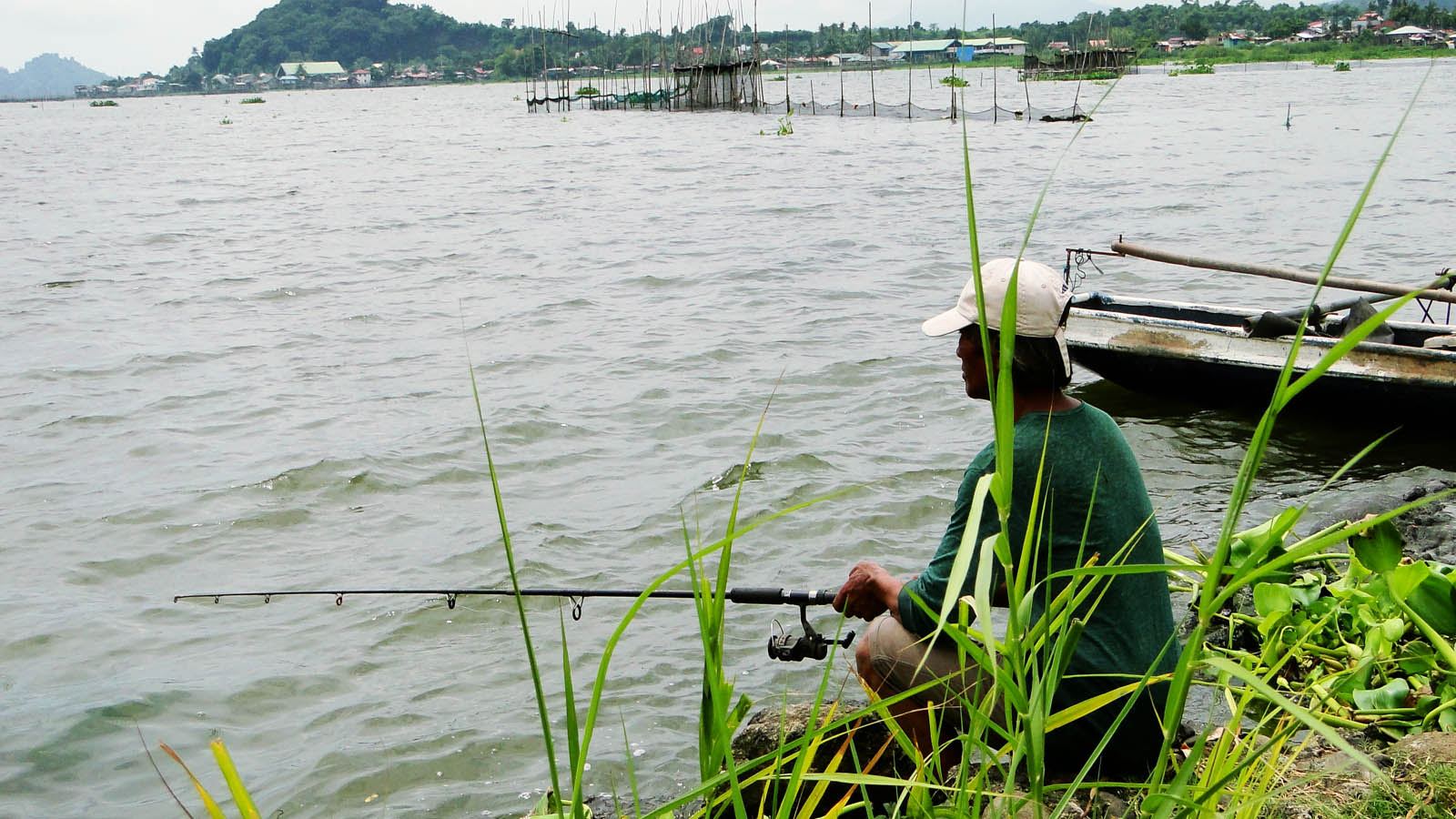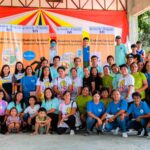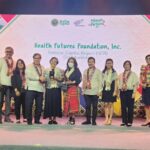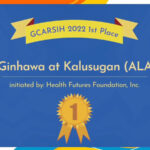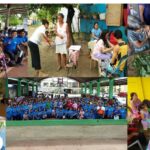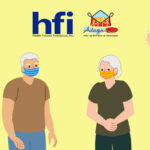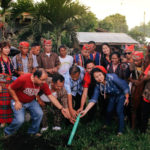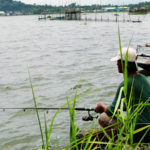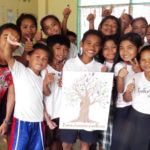“Ibalik natin and diwa ng lawa (let us reclaim the lake’s glory)." - LLDA Sec. Acosta.
Ka Nikanor, clothed lightly in shorts and shirt, a hat covering his sun-burned face, wakes up at four in the morning. His hands describe the roughness of his trade. Weary and frustrated, he ventures to the wide span of Laguna lake, wooing the waters just as his father and his father’s father had done before. At the end of the day, he brings with him a few kilos of kanduli and mamaling, later to be sold in a talipapa a long walk away.
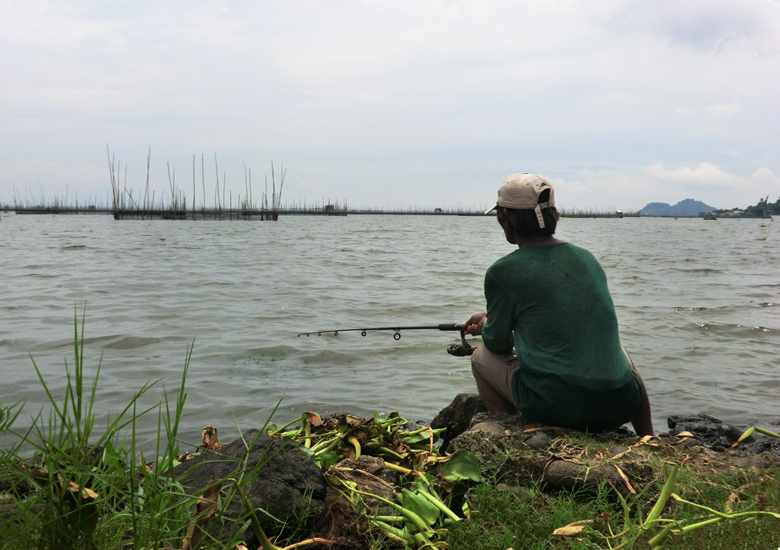
It was not like this years ago—things were much better then. “Dati, ang isang kilo ng mamaling ay bumibenta ng 25 peso; ngayon, dahil hindi na masarap ang isda, mga limang piso nalang. Minsan, umaabot sa punto na wala talagang bumibili (Not long ago, a kilo of bighead carp costs around 25 pesos; now, because the fish taste bad, they only cost around five pesos. It comes to a point when no one buys our fish).”
The variety and quantity of fish Ka Nicanor catches have also plummeted. Aggravated by the burden of buyers’ fear on his produce’s safety, he stands in the forefront of the lake’s and her people’s battle to survive. Fisherfolks like Ka Nicanor have suffered most from the decades-long degradation of Lake Laguna. The deterioration of the Lake ecosystem has been insidious and pervasive. The bounty of the lake is now in fleeting distance. The sought-after white goby is sparse and endemic species have been replaced by fish pens and tons of bangus, tilapia, janitor fish, and knife fish. The lablab has been replaced by horizons of kiapo, ‘water lily’, duckweed, and floating pieces of plastic. The blue waters are now but anecdotes of an aging generation. The list of problems is long: heavy metals, domestic waste, coliform contamination, eutrophication and algal bloom, siltation, invasive fish species, low dissolved oxygen, fish kills, among many. The West side of the lake welcomes the megacity of Metro Manila and all over; the shift to an urbanized setting from rural neighborhoods is obvious, a social dynamics that Dr. Roger Concepcion of the University of the Philippines Los Baños likens to the Indonesian desakota.
What has been pristine had transformed to become a manifest of the seeming incompatibility of progress with nature, of society’s desire to flourish with the exploitation of its natural resources, of humanity’s quest to advance its civilizations. But progress is not to blame. Today’s mise-én-scene of Laguna Lake is one brought by unsustainable practices and wanton disregard—a tragedy of the commons prevented if only people lived with the understanding of generational equity and the realization of nature and society’s linkage.
The largest lake in the country and third in Southeast Asia, Laguna de Bay has an expanse of 911 sq. km., fills around 5.6 million Olympic-sized swimming pools (at 2,250,000 cubic meters) and is bounded by a 285-km shoreline. With a catchment area of 45,000 sq. km. and fed by 21 tributaries including Pasig and Pagsangjan, the lake is a significant natural resource with a watershed containing 66 local government units and a population of more than 11.2 million. In terms of navigation, tourism, aquaculture, domestic and industrial water supply, history and culture, her value could not be underestimated. But as Ka Archie, co-chairperson of Los Baños’ Kilusang Lawa-Kalikasan (KLK), an environmental watch group, shares “namamatay na ang Lawa (the lake is dying).” Many studies have affirmed this stark picture that few has tried to change.
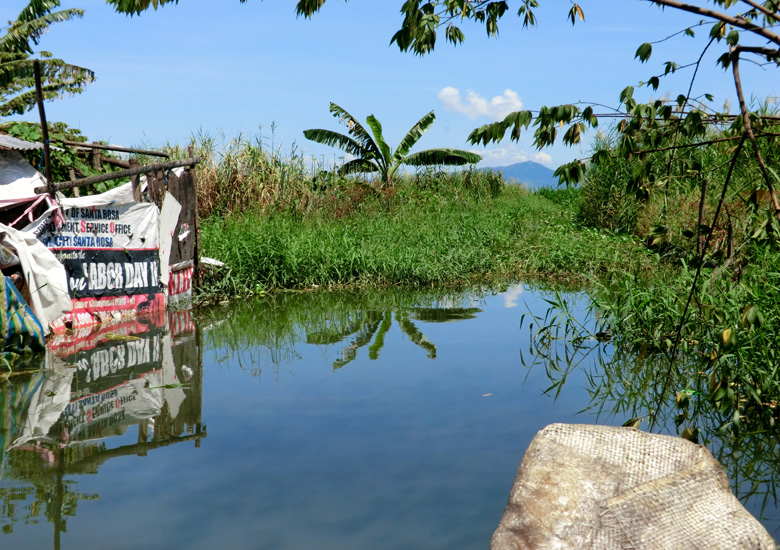
The body of literature regarding Laguna Lake stretches back to the time of Dr Jose Rizal. His El Filibusterismo opens with a steamer sailing upstream Pasig River from Manila to Laguna Lake and the prequel, while his Noli me Tangere, ended in the same lake with protagonists Elias and Crisostomo Ibarra escaping the guardia civil. In terms of scientific research, various institutions have tackled subjects as esoteric as limnology, stratigraphy and biomass estimation to more familiar ones such as organic and heavy metal pollutants, biodiversity and resource management and economics. These studies reveal the topographic features of the Lake, the ecosystem dynamics, the quantitative interaction between industries, households and the lake biota and other anthropogenic influences. With land use conversion, increasing migrant population and informal settlements unabated, massive solid wastes and pollution overload push the lake water deterioration close to a tipping point of an ecological disaster. There, however, remains paucity in the linkage of these known (the lake’s degraded condition) and the unknown (such as human health and nutrition). This lapse in literature is especially true in terms of the long-term sustainability, security and safety of lake resources. How will this disaster affect the millions of people living in the Laguna Lake’s watershed? How will this affect those who sustain and subsist mainly from it, those like Ka Nicanor?
Research as a Tool for Social Change
“Yes, we can!” was the banter of Ka Nikanor, Ka Archie and their fellow fisherfolk in the end of Dr. Ryohei Kada’s talk. Not unlike the electoral slogan of the famous American Democrat promising change, Dr. Kada echoed the statement as he welcomed fisherfolks, local government officials and local and international researchers in the Community Forum 2012. The Forum, held 27-28 September, 2012 at the Development Academy of the Philippines, Tagaytay City, “combines science to enriching traditional knowledge of community people who, with meager resources, have established unquantifiable wisdom to survive the challenges posed by multiple risks from ecological deteriorations.”
Leading the ongoing study, Managing Environmental Risks to Food and Health Security in the Laguna Lake Watershed, or Lake Health, Environment and Diversity (LakeHEAD) by the Research Institute for Humanity and Nature (RIHN-Kyoto, Japan), Health Futures Foundation, Inc. (HFI), University of the Philippines (UP) Manila, UP Los Baños and Laguna Lake Development Authority (LLDA), Dr. Kada has partnered with leading scientists in health and resource management to equip communities along Laguna Lake with the knowledge and understanding that clean environment is a precondition to ecological safety, food and health security. With an approach that is both community-based and participatory, the distinct and seminal LakeHEAD series of study now runs on its final fiscal year, having produced startling results that push for policy development to enable people and catalyze lake sustainability. Having confirmed their fears, ‘yes we can’ reflects some two-hundred or so participants’ esprit de corps in saving the lake and thus reclaim their livelihood, health, wellness and wealth. The LakeHEAD is a partnership of the academe and community, an advocacy and a people-centered thrust:
“The LakeHEAD is the first of intra-institutional research on environment, food and public health that combined academic and research institutions with Policy/Planning Institutions in Philippines and Japan,” describes a LakeHEAD brochure in the Forum, “to generate, analyze and integrate comprehensive, multi-relational ecological risk data and information with social and economic needs of stakeholders, particularly the vulnerable poor living in high health and flooding risk areas, in the rapidly changing land use, environment and climate in the Laguna de Bay Watershed”.
Dr. Jaime Z. Galvez Tan, leader of the LakeHEAD Health and Nutrition Team juxtaposes that the Forum’s purpose to that of an arena of knowledge sharing. Researchers “share the study’s initial findings that may be subject to a myriad of reactions – surprise, denial or even anger,” Dr. Galvez Tan told participants. “Any reaction, no matter how strong is very much welcome. Let them bubble to the surface for these are expressions of our deep concern for the welfare of man and of the environment.”
Paraphrasing the words of former United Nations Secretary-General Kofi Annan: the people most vulnerable are least able to protect themselves. This concern is translated into the lake’s context. Understanding the primary role of communities towards empowerment, much has to be learned from the creative disaster prevention efforts of poor communities in developing countries like the Philippines.
In the micro- and meso-systems, the need to empower local communities stands the same. Fisherfolks like Ka Nicanor and various local organizations were in attendance to listen and actively share their accounts, comments and suggestions. These organizations included the Bae Women’s Volunteer Group, Fisheries and Aquatic Resources Management Council (FARMC), Kalikasan-Southern Tagalog and other fisherfolk, fish cage operators and local community groups.
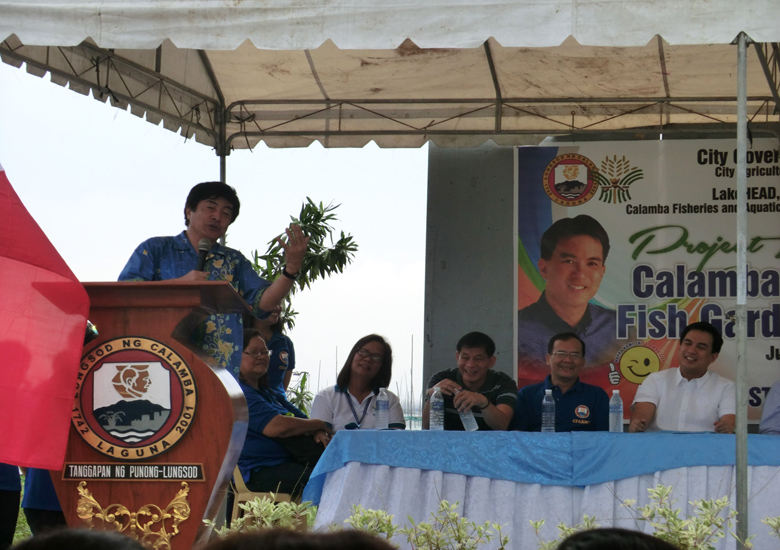
A Sense of Urgency
“The best thing that happens to the RIHN’s global participation to environmental studies is what the LakeHEAD project will achieve in the social development platform of the Community Forum 2012,” Professor Narifumi Tachimoto, Director General of the Research Institute for Humanity and Nature, enthused, “stakeholders being co-equal partners of experts from the Philippines and Japan to analyzing ecological risks for ensuring food and health security in the Laguna de Bay Watershed region.”
Assuring RIHN’s continued support, Professor Tachimoto praised the endeavor of the LakeHEAD and the Community Forum in enabling transformation, “redefining science in society to improve dialogue and stimulate local, national and international bodies in designing solutions”.
“The Forum basically dwelt on harmony of nature with communities: seeking to empower stakeholders through direct participation in understanding contemporary ecological abnormalities in and around the Laguna de Bay Region,” Dr. Kada described the event.
“The Community Forum 2012 is organized to serve as venue for exchanging information, facts, issues and challenges between the Laguna de Bay communities and the researchers from the Philippines and Japan. The traditional tacit knowledge developed by the lake stakeholders over the years of exposures to various climate and environmental changes is validated and reinforced with scientific evidences to improve their value in forewarning local communities from impending ecological risks and environmental disasters.
“Likewise, the Community Forum 2012, being the venue for community-oriented analysis of the ecological risks to health and food security, has tasked experts from the Philippines and Japan and their counterpart stakeholders the identification of lake hot spots and the establishment of community-based Early Warning Systems to improve the capacity of the lake stakeholders to forecaring their livelihood and overall welfare.”
With the participation of local governments, the Forum brought together partners from the Department of Environment and Natural Resources (DENR), Provincial Planning Development Office of Rizal and Laguna, City Environment and Natural Resources Offices (CENRO), National Mapping and Resource Information Authority (NAMRIA), Bureau of Fisheries and Aquatic Resources (BFAR), City and Municipal Health Offices, Department of Agriculture, Philippine Social Development Network (PSDN), Bureau of Sewage and Wastewater Management (BSMW) and Department of Agriculture (DA).
Sharing her accounts of how Laguna Lake affects her people welfare and what her city is doing to mitigate impacts, Santa Rosa City Mayor Hon. Arlene B. Arcillas emphasized, “The city government needs to take measures to maintain a clean environment.” As a model city for sustainable development, Hon. Arcillas compares the Forum’s community-based approached to her city’s participatory government, “cities need to listen to the communities and this is how they can plan effectively.”
Speaking in behalf of the LLDA, Hon. Sec. J. R. Nereus O. Acosta reflected on the same initiatives, “As the world faces the mounting impacts of climate change and greater environmental challenges, our collective work and partnerships assume a higher sense of urgency. There is no price to the delicate balance of nature, society and economy, but if we work tirelessly for this convergence, we at the very least lessen the grave consequences of ecological damage and ecosystems degradation.”
“Ibalik natin and diwa ng lawa (let us reclaim the lake’s glory),” added Sec. Acosta. Alluding to this urgency, he expressed, “Time may not necessarily be on our side, but that doesn’t mean we should give up. Time is also the only thing that we’ve got.”
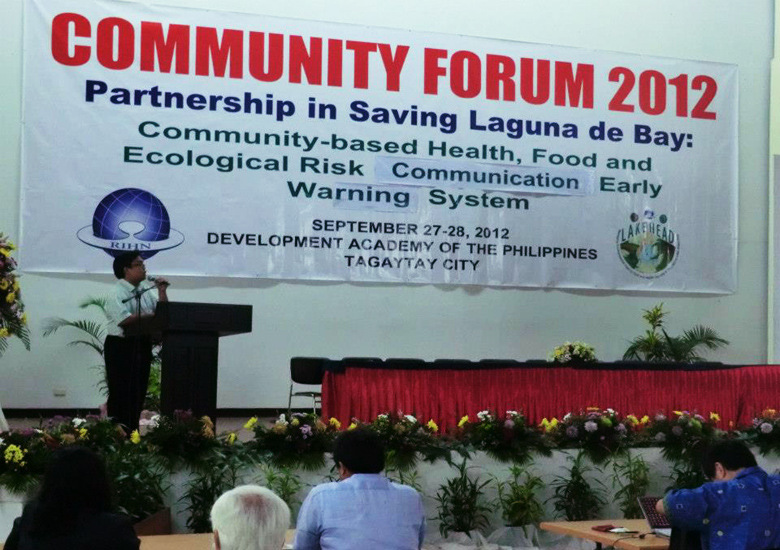
Fitting the Puzzle Together: The First Day
Three parallel sessions were held to discuss about major themes of study and policy development in Laguna Lake: Facts, Issues and Challenges on the Lake’s Changing Condition; Risk Management and Policies; and Risk Communication and Community Participation. The first parallel session, as synthesized by LakeHEAD Health and Nutrition Team’s Dr. Amiel Nazer C. Bermudez, noted that:
“Human activities such as land use change may help explain high levels of heavy metals in western urbanized regions of the lake watershed area (as discussed in Present levels of heavy metals in river and lake waters and bottom sediments in the Laguna de Bay watershed by Dr. Satoshi Saito), reduction in plant and wildlife and wildlife biodiversity (Cynthia Buen’s On ecological risk analysis related to lake deterioration and impacts on water plants, number of species and volume of harvest and Dr. Damasa B. Magcale-Macandog’s Impact of land-use change on plant, mammal and bird diversity and its implications on food security in the Sta. Rosa–Silang Sub-watershed) and decreases in primary productivity (Dr. Fernando P. Siringan’s Influence of salinity on primary productivity of Laguna de Bay during the last 150 tears from sediment geochemistry).
“These activities result in environmental degradation, which in turn decreases access to resource-producing activities, increases poverty incidence and exposure to risks (Fe M. Rañola’s Food insecurity of households in watershed communities in the Laguna Lake Region). As shown by empirical observations, major changes in the quality of the water have resulted to changes in fish quality and quantity, decreasing the price of fish and adversely affecting the incomes of small-scale fishermen (as recounted in Ka Nicanor’s testimony, Narration of fisherfolks’ observations on changes in fish quality and effects on livelihood and daily fish catch for food of family). As a way of addressing the effects of lake degradation, city governments have initiated activities to empower communities.
“From a research perspective, it is important to integrate in a map the findings of studies and it is advisable to have a unified format for collecting and reporting map-related information in the country (as recommended in Dr. Kiyoyuko Yaota’s Spatial data integration for risk identification and awareness).”
The second parallel session, summarized by Maria Francesca O. Tan of UP Los Baños presented several major points including fisherfolks’ alternative sources of livelihood during declining fish catch and fish kills as the most visible ecological disturbance (according to Romeo San Juan of Pila, Laguna in his testimony, Narration on how fisherfolks cope with declining fish catch and their alternative livelihood and food and food sources while waiting for the harvest of their fish stocks and Jay Rolusta, Municipal Councilor of Los Baños and Diego Vargas’, KLK Secretary, Description of coping practices for fishpen management to address fishkills and changes in lake productivity); food insecurity in individual and household levels (Dr. Noel R. Juban’s Baseline assessment of food insecurity and coping strategies in households in the Santa Rosa Sub-watershed area); flood risks which magnify other risks to health and livelihood (Dr. Bam H.N. Razafindrabe’s Community resilience to flood disasters – Case study of Santa Rosa Sub-watershed); the stressed and deteriorated water quality of the lake (Dr. Macrina T. Zafaralla’s Degraded creek habitat restoration through use of an aquatic macrophyte bio-sorption system); agroforestry as a conservation strategy to address issues of land conversion (Dr. Katsuya Tanaka’s Payment for ecosystem services through agroforestry in the Philippines); and institutional partnership and networking with the DA (Dr. Silvino Q. Tejada’s Mainstreaming ecological risks into the DA programs and policies).
The third parallel session focused on risk communication and community participation and highlighted two important studies by the Health and Nutrition Team. Dr. Victorio B. Molina’s study, Health risks from heavy metals in fish from Laguna Lake, and Dr. Lynn Crisanta R. Panganiban’s Risk factors to heavy metal poisoning among residents in four communities in Santa Rosa City, Laguna were taken with both dread and relief by both fellow researchers and the community participants. Dr. Molina’s study presents the dangers of fish caught from Laguna Lake to health in terms of non-carcinogenic hazard quotient and carcinogenic health effects. His study proves that fish caught in Laguna Lake are “not fit for long-term human consumption due to lead, mercury and arsenic contamination.” Dr. Panganiban’s study, on the other hand, showed that some children in the Santa Rosa watershed have significant blood and hair lead and mercury levels. Her study also presented correlates between low IQ scores and high heavy metal levels.
Validating Dr. Molina and Dr. Panganiban’s studies in the session, Florencio G. Vino, a fisherfolk from Muntinlupa City narrated on how they describe ‘bio-signals’ to indicate changes in lake water and fish behaviors before, during and after fishkill events. Several studies also consolidated with communicating these risks such as Consuelo L. Santos and Archie Mauricio’s On analysis and describing sources and methods of exchanging information and solutions for ecological risks to food and health; Dr. Tadayoshi Masuda’s Where and how are food and health risks distributed? – From household surveys in the Santa Rosa Sub-watershed, Dr. Gina P. Nilo’s Decision-support tool for vulnerability and suitability assessment: Application for sustainable rural development in Central Philippines and Dr. Rogelio N. Concepcion’s Yaman ng Lawa: Community-based lake ecology learning center.
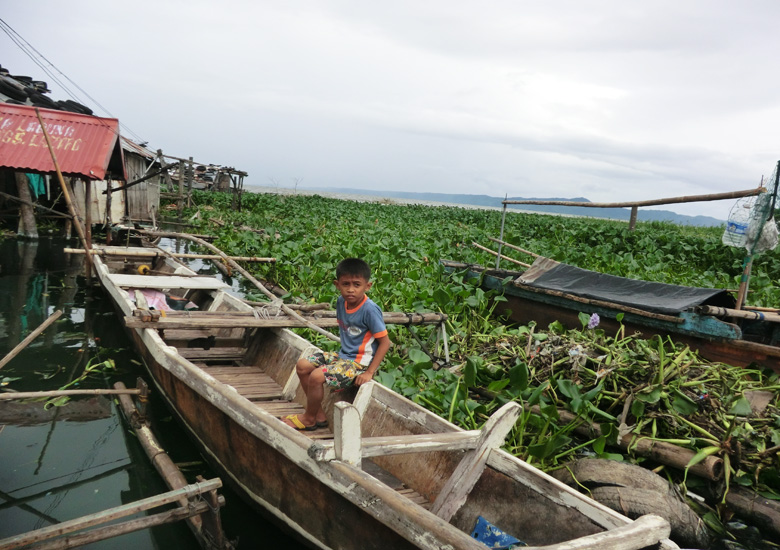
Success of the Commons: The Second Day
“The conduct of studies linking environmental hazards to human diseases and subsequent risk identification are important undertakings since they provide policy directions toward effective public health interventions and environmental remediation strategies,” Dr. Bermudez explained in the second day of the Forum, synthesizing the outputs of the first parallel session. “Apart from this, there is a need to formally monitor and evaluate proposed interventions that manage environmental degradation. This is the science of policy directions!”
Side-by-side this concept of research as guide to policy, the second day of the Forum was venue to lectures strategizing on action planning. The first plenary session included Sec. Acosta’s LLDA plans and programs in addressing developmental changes and ecological risks, Dr. Roberto F. Rañola’s Impact of environmental hazards and risks on the environment and food security: A framework, Dr. Galvez Tan’s Baseline description of health status and health-related factors of households in the Sta. Rosa Sub-watershed area, Dr. Kada’s Contemporary issues and challenges for research on food and health security: Opportunities for regional and international research collaboration and Dr. Masahisa Nakamura of Shiga University’s Integrated lake basin management (Lake and communities): Japanese experience.
Grounded on his country’s experience on Lake Biwa, Dr. Nakamura shares the concept of hysterysis, “systems would not fully recover and a regime shift may set in”. A thought also shared by Sec. Acosta, “we may not bring back the lake to its days in the ‘50s or ‘60s, but we will work together to improve it from what it is now,” this leads to an optimism best coupled with proactive solutions. As Dr. Nakamura concluded, “We make mistakes but long and persistent efforts will eventually pay off.”
Such “persistent effort” has been realized in same ecological disasters around the world. Providing a picture of how other countries in Southeast Asia addressed the incompatibility of uncontrolled human activity and nature, the second plenary session revolved around “International Perspectives and National Policies: Watershed Management and Ecological Risks to Food and Health”.
Dr. Trang Van Quang of the Danang University of Technology, Vietnam recounted his country’s similar problem in Danang City (in Pollution of groundwater source in Danang City: Current status and suggested methods for improvements). He suggested eco-technology combined with concerted community solid waste clean-up as possible measures to remediate Laguna Lake. Dr. Gamini Herath from the School of Business of Monash University, Malaysia emphasized on efficient communication between stakeholders and improved flood forecasting and warning systems (in Food security, health and natural disasters: Strategic issues with special reference to Malaysia). Working on the premise of payment for ecosystem services (PES), Dr. Bustanul Arifin of the University of Lampung, Indonesia gave examples of PES pilot programs that have successfully mitigated environmental overexploitation in the Indonesian provinces of Jambi, West Sumatra and Sumber Jaya (in Empowering ecosystem services in Indonesia: Integrating agro-environmental quality with local economic interests). Dr. Zen’ichiro Kawabata of RIHN reviewed and analysed causes of fishkills, recommending that the Philippines should formulate a protocol for investigation and prevention of fishkills (in Infectious diseases in the linkage of environment, pathogen and humans).
Following the plenary sessions was a panel discussion moderated by Dr. Ben S. Malayang III of the Siliman University. Dr. Rafael Guerrero III of UP Los Baños discussed the impacts of lake degradation on fish quality and diversity. “There are 22 fishes introduced in the Laguna Lake, more than 18 have been introduced for aquaculture and more than three have become invasive species. The Thai catfish has displaced the native hito,” lamenting the bland taste of the invasive species, the animated Dr. Guerrero cited years of studies on key water quality parameters.
Dr. Siringan explained issues on flooding and salinity, remarking on infrastructure developments in and around Laguna Lake tributaries that worsen flooding. “Where are the rivers?” he asked, pointing at the ‘lost’ tributaries stamped out by subdivisions, parks and houses on reclaimed lands. Dr. Ramon Pedro P. Paterno of the National Institutes of Health delivered a lecture on public health and management issues in Santa Rosa City, further stressing the role of multisectoral approach in addressing environmental threats to health. Dr. Karen Ann Jago-on of the UP Diliman’s School of Urban and Regional Planning introduced environmental governance, “This is our way forward: strengthen the collaboration mechanisms among stakeholders and responsible agencies, promote the use of reliable and accurate information to improve policy-making processes and institutionalize data monitoring and management.”
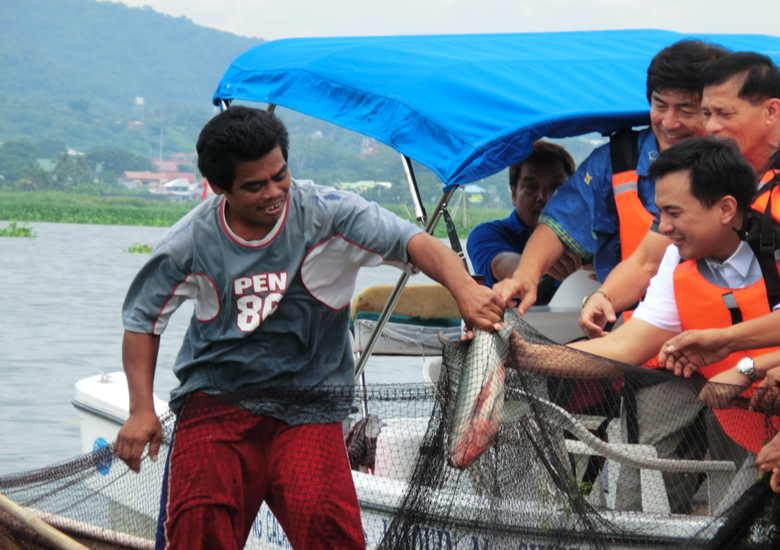
All is not lost
“The patterns tell it all!” exclaimed Ka Chino Santos of the KLK, reacting to the panel discussion. “These forum and proceedings constitute the scientific basis and strategy for rational management of the lake, in adopting an ecologically-based management.” Taking from his experience as a community leader, Ka Chino revealed the KLK and various fisherfolk organizations’ concerns:
“Capability and competence could be achieved only through strategic joint efforts between the concerned sectors. Among these- the government, the people, the civil society organizations and the academic community- we see indications of failure of governance,” he alludes to the LLDA’s mandate to the lake’s condition and the welfare of the people who live around it.
“If risks are increasing and not decreasing through the years, despite our efforts, there is something wrong with governance. An institution should focus on the research and the facts about Laguna Lake. KLK cannot advocate without any organization supporting and giving them reasons to be justified.”
This pain is felt by many fisherfolk. As Ka Archie said, “Kaming mga mangingisda ang pinakaagrabyado sa pagkasira ng Laguna de Baí. Nandirito ang aming kabuhayan. Kung sinong ang siyang may pinakakaunting naidulot sa pagkasira nito’y siya ring pinakaapektado (We fishermen are the most affected by the destruction of the Laguna Lake. It is here that our livelihood is. We who have least contributed to its degradation are ironically the ones most in peril.)”
It is along this direction that Mr. Socihi Mori of Japan’s Ministry of Education, Culture and Sports, Science and Technology concluded the Forum, congratulating the researchers and lauding the active and invaluable participation of Laguna Lake stakeholders. Closing the two-day event, Dr. Kada returned to RIHN’s environmental humanics, the convergence of cognitive and design sciences in making human progress and nature preservation compatible. Setting the next steps of the LakeHEAD project, Dr. Kada takes on the challenges raised in the Forum in behalf of the team.
Packing his bag after the applause and the photo-op, Ka Nicanor stood smiling besides his fellow fisherfolks, researchers, LLDA and government officials. Above them, the title of the Forum hung on the large auditorium stage, “Partnership in Saving Laguna de Bay: Community-based Health, Food and Ecological Risk Communication and Early Warning System”.
Truly, the two days have been a unique and interesting experience for Ka Nicanor. He tells us — his thoughts homeward Laguna de Baí, “Hindi pa patay ang Lawa. Tulungan n’yo kaming ibalik ang aming Lawa. (The Lake is not dead. Help us bring it back).”
Written by Allan Chester B. Nadate and Danya Agatha O. Go; Edited by Dyan Geleen B. Tuble
